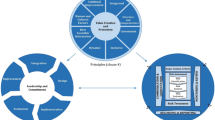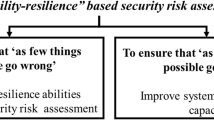Abstract
The security industry operates within a diverse and multi-disciplined knowledge base, with risk management as a fundamental knowledge domain within security to mitigate its risks. Nevertheless, there has been limited research in understanding and mapping security expert knowledge structures within security risk management to consider if parts of security risk management are unique from more general risk management. This interpretive study applied a technique of multidimensional scaling (MDS) to develop and present a psychometric map within the knowledge domain of security risk management, validated with expert interviews. The psychometric MDS security risk management concept map presented the expert knowledge structure of security risk management, demonstrating the inclusive and spatial locality of significant security risk concepts, conceptual complexity, uniqueness of the domain and the importance of the concept threat. Understanding security experts’ consensual knowledge of security risk may allow improved understanding of threat-based risk, the issue with applying probabilistic risk analysis against antagonist events, and improved teaching and learning within this knowledge domain.







Similar content being viewed by others
References
American Society for Industrial Security. (2000) Proceedings of the 2000 Academic/Practitioner Symposium, The University of Oklahoma, OK: American Society for Industrial Security.
Angus and Roberston (1992) Dictionary and Thesaurus. Sydney, Australia: Harper Collins Publishers.
ASIS International. (2003a) Proceedings of the 2003 Academic/Practitioner Symposium, The University of Maryland, MD: ASIS International.
ASIS International. (2003b) Proceedings of the 2003 Academic/Practitioner Symposium, The University of Maryland, MD: ASIS International.
ASIS International. (2007) Academic institutions offering degrees and/or courses in security, http://www.asisonline.org/education/universityPrograms/traditionalprograms.pdf, accessed 7 March 2007.
ASIS International. (2009) Security body of knowledge (BoK): Substantive considerations. Unpublished ASIS International Academic/Practitioner Symposium 2009, ASIS International.
Association of Universities and Colleges of Canada. (2005) Speaking for Canada's universities at home and abroad, http://oraweb.aucc.ca/pls/dcu/, accessed 28 July 2005.
Aven, T. (2008) Risk Analysis: Assessing Uncertainties Beyond Expected Values and Probabilities. West Sussex, UK: John Wiley & Sons.
Bar, V. and Travis, A.S. (1991) Children's views concerning phase changes. Journal of Research in Science Teaching 28 (4): 363–382.
Beard, B. and Brooks, D.J. (2006) Security Risk Assessment: Group Approach to a Consensual Outcome, Proceeding of the 7th Australian Information Warfare and Security Conference. Perth, Australia: Edith Cowan University, pp. 5–8.
Bennett, B. and Rolheiser, C. (2001) Beyond Monet: The Artful Science of Instructional Integration. Toronto, Canada: Bookation.
Bier, V.M. (1999) Challenges to the acceptance of probabilistic risk analysis [Electronic version]. Risk Analysis 19 (4): 703–710.
Bier, V.M. (2007) Choosing what to protect [Electronic version]. Risk Analysis 27 (3): 607–620.
Borges, T.A. and Gilbert, J.K. (1999) Mental models of electricity. International Journal of Science Education 21 (1): 95–117.
Brooks, D.J. (2009a) Key Concepts in Security Risk Management: A Psychometric Concept Map Approach to Understanding. Saarbrucken, Germany: VDM Verlag.
Brooks, D.J. (2009b) What is security: Definition through knowledge categorisation. Security Journal, DOI 101057/sj.2008.18, 1–15.
Cheng, C.C. (2004) Statistical approaches on discriminating spatial variation of species diversity. Botanical Bulletin of Academia Sinica 45: 339–346.
Clancey, W.J. (1997) The conceptual nature of knowledge, situations, and activity. In: P.J. Feltovich, K.M. Ford and R.R. Hoffman (eds.) Expertise in Context: Human and Machine. Menlo Park, CA: The MIT Press, pp. 247–291.
Cohen, L., Manion, L. and Morrison, K. (2002) Research Methods in Education, 5th edn. London: RoutledgeFalmer.
Cox, L.A. (2008) Some limitations of ‘risk=threat x vulnerability x consequence’ for risk analysis of terrorist attacks [Electronic version]. Risk Analysis 28 (6): 1749–1761.
Cox, T.F. and Cox, M.A.A. (2000) Multidimensional Scaling: Monographs on Statistics and Applied Probability, Vol. 88, 2nd edn. Boca Raton, FL: Chapman & Hall/CRC.
Davidson, M.A. (2005) A matter of degrees. Security Management 49 (12): 72–99.
Eysenck, M.W. and Keane, M.T. (2002) Cognitive Psychology: A Student's Handbook, 4th edn. New York: Psychology Press.
Fischer, R.J. and Green, G. (2004) Introduction to Security, 7th edn. Boston, MA: Butterworth Heinemann.
Garlick, A. (2007) Estimating Risk: A Management Approach. Aldershot, UK: Gower Publishing Company.
Good Guides. (2004) Helping you make decisions about where and what to study in Australia, http://www.thegoodguides.com.au/ggcontent/course/id, accessed 28 October 2004.
Hesse, L. and Smith, C.L. (2001) Core Curriculum in Security Science, Proceedings of the 5th Australian Security Research Symposium, Perth, Western Australia. Perth, Australia: Edith Cowan University, pp. 87–104.
Horvath, J. (2004) The fear factor, http://www.telepolis.de/english/inhalt/te/18187/1.html, accessed 3 September 2004.
Howard, J. (2004) Business government forum on national security, http://www.safeguardingaustralia.org.au/Questions/Howard-address-23June04.doc, accessed 3 July 2004.
Hoz, R., Bowman, D. and Chacham, T. (1997) Psychometric and edumetric validity of dimensions of geomorphological knowledge which are trapped by concept mapping. Journal of Research in Science Teaching 34 (9): 925–947.
Jay, C. (2005) Big debacles help shape a new science. The Australian Financial Review, 17 March: 2.
Johnson-Laird, P.N. (1983) Mental Models: Towards a Cognitive Science of Language, Inference and Consciousness. Cambridge, UK: Cambridge University Press.
Johnson, R.A. and Wichern, D.W. (2002) Applied Multivariate Statistical Analysis, 5th edn. Upper Saddle River, NJ: Prentice-Hall.
Jones, D.E.L. and Smith, C.L. (2005) The development of a model for the testing and evaluation of security equipment within Australian Standard/New Zealand Standard AS/NZS4360:2004 – Risk management. Recent Advances in Counter-Terrorism Technology and Infrastructure Protection.
Kealy, W.A. (2001) Knowledge maps and their use in computer-based collaborative learning environments. Journal of Computing Research 25 (3): 325–349.
Kellogg, R.T. (2003) Cognitive Psychology, 2nd edn. Thousand Oaks, CA: Sage Publications.
Kidd, S. (2006) The Security Institute yearbook and directory of qualifications 2006, http://www.security-institute.org/yearbook.html, accessed 25 June 2007.
Kruskal, J.B. and Wish, M. (1978) Multidimensional Scaling, Vol. 07, London: Sage Publications.
Lockhart, R.S. and Craik, F.I.M. (1990) Levels of processing: A retrospective commentary on a framework for memory research. Canadian Journal of Psychology 44: 87–112.
Manunta, G. (1996) The case against: Private security is not a profession. International Journal of Risk, Security and Crime Prevention 1 (3): 233–240.
Manunta, G. (1999) What is security? Security Journal 12 (3): 57–66.
Manunta, G. (2002) Risk and security: Are they compatible concepts? Security Journal 15 (2): 43–55.
Markham, K.M., Mintzes, J.J. and Jones, M.G. (1994) The concept map as a research and evaluation tool: Further evidence of validity. Journal of Research in Science Teaching 31 (1): 91–101.
Martinez-Torres, M.R., Garcia, F.J.B., Marin, S.L.T. and Vazquez, S.G. (2005) A digital signal processing teaching methodology using concept-mapping techniques. IEEE Transactions on Education 48 (3): 422–429.
McGill, W.L., Ayyub, B.M. and Kaminsky, M. (2007) Risk analysis for critical asset protection [Electronic resource]. Risk Analysis 27 (5): 1265–1281.
Morgan, G. and Henrion, M. (1990) Uncertainty: A Guide to Dealing With Uncertainty in Quantitative Risk and Policy Analysis. New York: Cambridge University Press.
Norman, D.A. (1983) Some observations on mental models. In: D. Gentner and A.L. Stevens (eds.) Mental Models. Hillsdale, NJ: Lawrence Erlbaum Associates, pp. 7–14.
Novak, J.D. (1990) Concept mapping: A useful tool for science education. Journal of Research in Science Education 27: 937–949.
Novak, J.D. (1998) Learning, Creating and Using Knowledge: Concept Maps as Facilitative Tools in Schools and Corporations. Mahwah, NJ: Lawrence Erlbaum Associates.
Novak, J.D. and Gowin, D.B. (1984) Learning How to Learn. Cambridge, USA: Cambridge University Press.
Pennebaker, J.W., Francis, M.E. and Booth, R.J. (2001) Linguistic Inquiry and Word Count (LIWC2001). Mahwah, NJ: Erlbaum Publishers.
Power, M. (2007) Organized Uncertainty: Designing a World of Risk Management. Oxford, UK: Oxford University Press.
Reisberg, D. (2001) Cognition: Exploring the Science of the Mind, 2nd edn. New York: W. W. Norton & Company.
Rennie, L.J. and Gribble, J. (1999) A Guide to Preparing Your Application for Candidacy. Perth, Western Australia: Curtin University of Technology.
Risk Management Institute of Australasia. (2007b) Security risk management body of knowledge, http://www.securityprofessionals.org.au/2007SRMBOK.htm, accessed 24 January 2007.
Ruiz-Primo, M.A., Schultz, S.E., Li, M. and Shavelson, R.J. (2001) Comparison of the reliability and validity of scores from two concept-mapping techniques. Journal of Research in Science Teaching 38 (2): 260–278.
Simonsen, C.E. (1996) The case for: Security management is a profession. International Journal of Risk, Security and Crime Prevention 1 (3): 229–232.
Smith, C.L. (1984) Learning astronomy and the organisation of astronomy concepts in semantic memory. Unpublished doctoral thesis, Murdoch University, Perth, Western Australia.
Smith, C.L. (2001a) Security science as an applied science? Australian Science Teachers’ Journal 47 (2): 32–36.
Smith, C.L. (2001b) Security science: An emerging applied science. Journal of the Science Teachers Association of Western Australia 37 (2): 8–10.
Smith, C.L. (2003) Understanding Concepts in the Defence in Depth Strategy, Security Technology, 2003. Proceedings, IEEE 37th Annual 2003 International Carnaham Conference. Taipei, Taiwan, Republic of China, pp. 8–16.
Standards Australia. (2004a) AS/NZS4360:2004 Risk Management. Sydney, Australia: Standards Australia International.
Standards Australia. (2004b) AS/NZS 4360: 2004 Risk Management. Sydney, Australia: Standards Australia.
Standards Australia. (2004c) HB221 Business Continuity Planning. Sydney, Australia: Standards Australia International.
Standards Australia. (2004d) HB436:2994 Risk Management Guidelines: Companion to AS/NZS4360:2004. Sydney, Australia: Standards Australia International.
Standards Australia. (2006) HB 167:2006 Security Risk Management. Sydney, Australia: Standards Australia.
Standards Australia. (2009) AS/NZS ISO31000:2009 Risk Management – Principles and Guidelines. Sydney, Australia: Standards Australia.
Standards Australia. (2011) Imagine a world without standards. Brochure. Homebush.
Stein, E.W. (1997) A look at expertise from a social perspective. In: P.J. Feltovich, K.M. Ford and R.R. Hoffman (eds.) Expertise in Context: Human and Machine. Menlo Park, CA: The MIT Press, pp. 181–194.
Streveler, R., Miller, R.L. and Boyd, T.M. (2001) Using an on-line tool to investigate chemical engineering seniors’ concept of the design process. Paper presented at the Annual Meeting of the American Educational Research Association, Seattle, WA.
Talbot, J. and Jakeman, M. (2008) SRMBOK: Security Risk Management Body of Knowledge. Carlton South: Risk Management Institution of Australasia.
Tate, P.W. (1997) Report on the Security Industry Training: Case Study of an Emerging Industry. Perth, Australia: Western Australian Department of Training. Western Australian Government Publishing.
Trochim, W.M.K. (1989) An introduction to concept mapping for planning and evaluation. Evaluation and Program Planning 12 (1): 1–16.
Trochim, W.M.K. (1993) The reliability of concept mapping, http://www.socialreserachmethods.net/reserach/Reliable/reliable.htm, accessed 24 July 2005.
Trochim, W.M.K. (2005) Concept mapping. http://www.socialresearchmethods.net/kb/conmap.htm, accessed 28 July 2005.
Trochim, W.M.K. and Cook, J.A. (1994) Using concept mapping to develop a conceptual framework of staff's views of a supported employment program for persons with severe mental illness. Journal of Consulting and Clinical Psychology 62 (4): 766–775.
Turner, P. (2002) Multidimensional scaling analysis of techniques used by physiotherapists in Southeast Australia: A cross-national replication. Australian Journal of Physiotherapy 48: 123–130.
Wallace, A., Schirato, T. and Bright, P. (1999) Beginning University: Thinking, Researching and Writing for Success. Sydney, Australia: Allen & Unwin.
Zedner, L. (2009) Security: Keys Ideas in Criminology. London: Routledge.
Author information
Authors and Affiliations
Rights and permissions
About this article
Cite this article
J Brooks, D. Security risk management: A psychometric map of expert knowledge structure. Risk Manag 13, 17–41 (2011). https://doi.org/10.1057/rm.2010.7
Published:
Issue Date:
DOI: https://doi.org/10.1057/rm.2010.7




